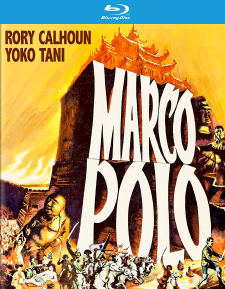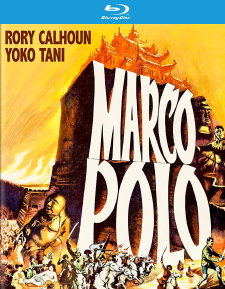Marco Polo (1962) (Blu-ray Review)

Director
Hugo Fregonese, Piero PierottiRelease Date(s)
1962 (February 7, 2023)Studio(s)
Alta Vista/Filmorsa/Panda Film/AIP (Kino Lorber Studio Classics)- Film/Program Grade: C+
- Video Grade: A-
- Audio Grade: B
- Extras Grade: B
Review
Marco Polo (L’avventura di un Cina, 1962) is the kind of film that’s much more interesting to watch for its production aspects and unusual combination of talent than as entertainment. The “peplum” genre was in full swing in Italy at this time, primarily sword-and-sandal films centered around the trials of Hercules and adventures of Maciste, but occasionally ambitious filmmakers there stretched with (slightly) bigger productions designed to appeal to an even wider international audience. An undernourished, would-be epic, Marco Polo was likely spurred by European press surrounding the impending production of Samuel Bronston’s all-star epic 55 Days at Peking (1963). Though shooting on that film had barely begun by the time Marco Polo was finished and ready for release, its imminent production had been widely reported at least as far back as 1961, press attention particularly focused on the construction of its impossibly huge recreation of Peking outside Madrid.
At about 1/20th the cost, Marco Polo couldn’t possibly compete with that film’s lavishness, but it’s fun to watch them try. Rory Calhoun, of all people, stars as the 13th century Venetian explorer, who traveled the Silk Road through Asia between 1271 and 1295. To say the film lacks historical verisimilitude would be an understatement; at times the lightweight film verges on something like “Carry on Marco Polo.” Rather, it’s pure escapism with a basic plot cribbed from The Thief of Bagdad with likeminded palace intrigue/outsider-saves-the-kingdom-type plotting, the kind of thing Universal cranked out in the mid-1940s.
Here, Polo is depicted as a Lothario and vagabond, irresistibly charming to all women, and far more interested in having a swell time than documenting Asia’s cultural anthropology. Hollywood actor Calhoun, primarily known for his Westerns, would seem an outlandish casting choice, and he is, though his mid-level screen charisma ends up being one of film’s main charms, though this is offset somewhat by the script’s condescending attitudes toward Asians.
Following travelogue images of Venice, the story shifts herky-jerky to Asia, where Polo picks up cheery guide Ciu-Lin (Michael Chow) en route. (Clearly he needs no interpreter; everyone speaks perfect English.) Mostly, the thin plot revolves around Polo’s romance with Princess Amurroy (Yoko Tani), daughter of the Grand Khan (Camilio Pilotto), whose Peking kingdom is threatened by the very Jaffarian Mongka (Robert Hundar). Siding with Cuday (Pierre Cressoy), leading freedom-fighters loyal to Khan, Polo breezily contrives to set things right in China.
An Italian-French co-production, Marco Polo is rife with Asian clichés and stereotypes, with the Chinese depicted as exotic but childlike, especially with regard to sexual matters. Marco Polo himself can’t help but laugh out loud watching a serious Buddhist religious ceremony, is disgusted by Chinese cuisine—except for spaghetti (called that by the Chinese), which he eats with his fingers—and is downright churlish toward a friendly merchant spicing up his business with a little sleight-of-hand magic. So backward are the Chinese, the film claims, that it’s up to Marco Polo to make practical use of gunpowder, he all but invented the cannon, no matter that the Chinese had been using both in warfare for centuries.
Like 55 Days at Peking, Asians (other than Yoko Tani in this case) are limited to playing extras and the smaller supporting parts, while non-Asians like Pilotto, Cressoy, and Hundar get to sink their teeth into the plum Chinese roles. This “yellowfacing” works fairly well in 55 Days, mainly because the writing of the political conflict is so much more intelligent. Marco Polo breaks with convention by not having these westerners wear Asian eye make-up and this, combined with presumably Italian tastes, lends these characters an especially unreal quality. When Ciu-Lin visits his aunt, for instance, she’s played by a chubby, short Italian actress playing her part like a doting Italian Mama in a TV commercial for pasta sauce.
As writer Tim Lucas expands upon in his excellent, fact-filled audio commentary track, the actors appearing in Marco Polo are far more interesting than the characters they play. Calhoun was a troubled youth, in an out of reform school and a professional thief while still in his teens. He eventually spent three years in prison, which came back to haunt him when, as a Hollywood star, his mugshot was splattered on the front page of Confidential magazine. Paris-born Yoko Tani was a cabaret star at high-end strip clubs. Friendships with director Marcel Carne and actor Roland Lesaffre (she married the latter) led to film work, Tani the go-to Asian of myriad European productions as varied as The Wind Cannot Read and First Spaceship on Venus. After her film career sputtered out and she divorced Lesaffre, she wound up taking her cabaret act to transgender clubs in São Paulo. Tiny Yong, playing Michael Chow’s love interest, enjoyed a big recording career as a pop star in France and close associations with that country’s elite art scene. Chow himself founded the Mr. Chow restaurant chain in 1968, attracting such diners as The Beatles, Clint Eastwood, and Frank Sinatra.
Tim Lucas also clarifies the behind-the-scenes roles played by Hugo Fregonese, who gets sole directing credit, and Piero Pierotti, who did much of the actual direction, though was primarily a screenwriter. As Lucas describes it, the arrangement sounds not unlike the Howard Hawks-Chritian Nyby dynamic on The Thing from Another World (1951) though probably neither Fregonese nor Pierotti was clamoring for authorship of Marco Polo.
Despite a few impressive sets, Marco Polo is too obviously compromised to compete with real Hollywood epics. Throughout the film Calhoun will admire impressive, authentic Asian landscapes lifted from La muraglia cinese, a 1958 travel documentary filmed in Totalscope. The ingenuity of the filmmakers integrating all these stock shots is sometimes amusing and clever: a scene of Ciu-Lin being threatened by arrows cuts between new footage of actor Chow with what looks like travelogue stock shots of Mongolians with bows and arrows. It’s clear, though, no one associated with Marco Polo set foot inside Asia during the making of the film. What is original to the film is sometimes laughably cheap. Particularly awful is a torture device with pinwheel blades used by Mongka, a contraption seemingly fashioned from balsa wood and aluminum foil.
But shooting in Italy was undeniably cheaper, with more bang for the lira; the costumes and sets are big-scale and colorful, and overall the film has a look not unlike the flurry of historical mini-epics made by 20th Century Fox and others during the earliest days (1953-54) of CinemaScope.
Marco Polo was itself in CinemaScope, photographed by Ricardo Pallottini. At least it’s credited as CinemaScope, “the trademark of 20th Century Fox,” say the credits, though during this period many CinemaScope-credit films were actually shot using newer, better lenses rather than Fox’s “mumps”-inducing Bausch & Lomb process. Kino’s transfer is notably sharp with none of the distortion associated with early CinemaScope titles. Although Marco Polo received a wide (if mostly drive-in) release via American International Pictures, Kino’s release is of the complete 103-minute English-dubbed (in Italy) export version, and not the retooled 95-minute AIP release, which had a different musical score, cut and (mostly using trims) expanded scenes. The image throughout, including the title elements, is impressively crisp with bright color and good contrast. Even the export version trailer, included as an extra feature, looks outstanding. The English 2.0 mono DTS-HD Master Audio track is likewise excellent for the period.
Kino’s audio commentary tracks have been wildly inconsistent, but Tim Lucas reliably crams this one with historical context and astute observations, tying the film to genre trends, to its immediate follow-up, Samson and the 7 Miracles of the World, and eventual release by AIP. It’s an excellent track. Also included is the aforementioned export trailer, as well as trailers for other Kino Lorber Blu-ray releases.
Dated in its views of “exotic” Asia and its people, too cheap to impress much as a historical epic, Marco Polo still has many points of interest, but more to outré film fans than general audiences today.
- Stuart Galbraith IV

